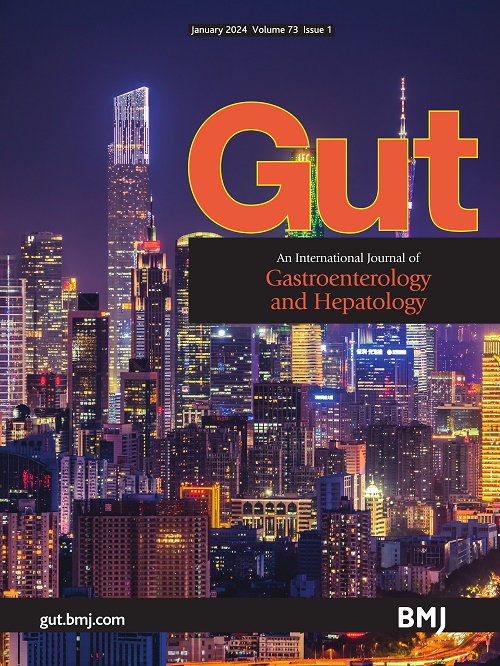Diagnostic efficacy of an extracellular vesicle-derived lncRNA-based liquid biopsy signature for the early detection of early-onset gastric cancer
IF 25.8
1区 医学
Q1 GASTROENTEROLOGY & HEPATOLOGY
引用次数: 0
Abstract
Background Early-onset gastric cancer (EOGC) is a lethal malignancy. It differs from late-onset gastric cancer (LOGC) in clinical and molecular characteristics. The current strategies for EOGC detection have certain limitations in diagnostic performance due to the rising trend in EOGC. Objective We developed a liquid biopsy signature for EOGC detection. Design We use a systematic discovery approach by analysing genome-wide transcriptomic profiling data from EOGC (n=43), LOGC (n=31) and age-matched non-disease controls (n=37) tissue samples. An extracellular vesicle-derived long non-coding RNA (EV-lncRNA) signature was identified in blood samples from a training cohort (n=299), and subsequently confirmed by qPCR in two external validation cohorts (n=462 and n=438), a preoperative/postoperative cohort (n=66) and a gastrointestinal tumour cohort (n=225). Results A three EV-lncRNA (NALT1, PTENP1 and HOTTIP) liquid biopsy signature was developed for EOGC detection with an area under the receiver operating characteristic curve (AUROC) of 0.924 (95% CI 0.889 to 0.953). This EV-lncRNA signature provided robust diagnostic performance in two external validation cohorts (Xi’an cohort: AUROC, 0.911; Beijing cohort: AUROC, 0.9323). Furthermore, the EV-lncRNA signature reliably identified resectable stage EOGC patients (stage I/II) and demonstrated better diagnostic performance than traditional GC-related biomarkers in distinguishing early-stage EOGC (stage I) from precancerous lesions. The low levels of this biomarker in postsurgery and other gastrointestinal tumour plasma samples indicated its GC specificity. Conclusions The newly developed EV-lncRNA signature effectively identified EOGC patients at a resectable stage with enhanced precision, thereby improving the prognosis of patients who would have otherwise missed the curative treatment window. Data are available on reasonable request.基于细胞外囊泡衍生lncrna的液体活检信号对早期发现早发性胃癌的诊断作用
背景早发性胃癌(EOGC)是一种致死性恶性肿瘤。它在临床和分子特征上不同于晚发性胃癌(LOGC)。由于EOGC呈上升趋势,目前的EOGC检测策略在诊断性能上存在一定的局限性。目的建立一种用于EOGC检测的液体活检特征。通过分析EOGC (n=43)、LOGC (n=31)和年龄匹配的非疾病对照(n=37)组织样本的全基因组转录组分析数据,我们采用了系统的发现方法。在训练队列(n=299)的血液样本中发现了细胞外囊泡衍生的长链非编码RNA (EV-lncRNA)特征,随后在两个外部验证队列(n=462和n=438)、一个术前/术后队列(n=66)和一个胃肠道肿瘤队列(n=225)中通过qPCR证实了这一特征。结果建立了3个EV-lncRNA (NALT1、PTENP1和HOTTIP)液体活检特征,用于EOGC检测,受试者工作特征曲线下面积(AUROC)为0.924 (95% CI 0.889 ~ 0.953)。EV-lncRNA签名在两个外部验证队列中提供了可靠的诊断性能(西安队列:AUROC, 0.911;北京队列:AUROC, 0.9323)。此外,EV-lncRNA标记可靠地识别可切除期EOGC患者(I/II期),并且在区分早期EOGC (I期)和癌前病变方面表现出比传统gc相关生物标志物更好的诊断性能。该生物标志物在术后和其他胃肠道肿瘤血浆样本中的低水平表明其GC特异性。结论新开发的EV-lncRNA标记可有效识别处于可切除阶段的EOGC患者,提高了准确性,从而改善了错过治愈治疗窗口期的患者的预后。如有合理要求,可提供资料。
本文章由计算机程序翻译,如有差异,请以英文原文为准。
求助全文
约1分钟内获得全文
求助全文
来源期刊

Gut
医学-胃肠肝病学
CiteScore
45.70
自引率
2.40%
发文量
284
审稿时长
1.5 months
期刊介绍:
Gut is a renowned international journal specializing in gastroenterology and hepatology, known for its high-quality clinical research covering the alimentary tract, liver, biliary tree, and pancreas. It offers authoritative and current coverage across all aspects of gastroenterology and hepatology, featuring articles on emerging disease mechanisms and innovative diagnostic and therapeutic approaches authored by leading experts.
As the flagship journal of BMJ's gastroenterology portfolio, Gut is accompanied by two companion journals: Frontline Gastroenterology, focusing on education and practice-oriented papers, and BMJ Open Gastroenterology for open access original research.
 求助内容:
求助内容: 应助结果提醒方式:
应助结果提醒方式:


